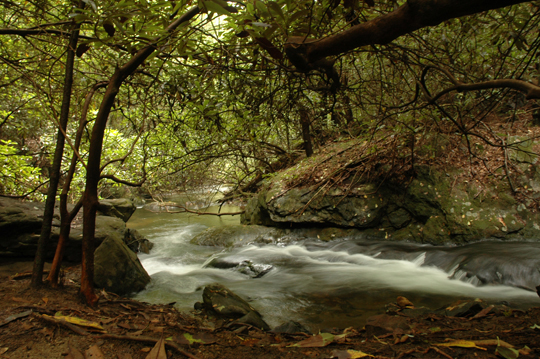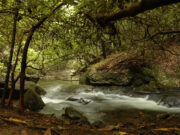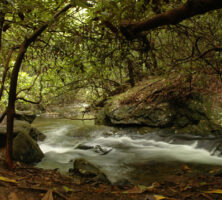When natural and cultural history are combined in a single narrative, one is said to be writing the environmental history of a place. In short, environmental history deals with the role and place of nature in human life.
First Peoples
The environmental history of the Georgia mountains starts with the Mississippians, the first people to live in permanent settlements there. At the time of first Spanish contact in 1540, Mississippian villages were well established along the mountains, major rivers, and tributaries. The floodplain river bottom gave the Mississippians access to easily tilled soils and close proximity to a wide range of animal and plant life. One of their most important natural resources was river cane, a bamboo-like reed that once grew abundantly in the Georgia mountains and was used for tools, arrow shafts, basketry, and construction.
As carriers of epidemic diseases, Hernando de Soto and other Spanish explorers who visited the north Georgia mountains during the sixteenth century were directly responsible for the decline and eventual demise of the Mississippians. Within a century after Spanish contact, it is estimated that the Mississippian population had decreased by 90 percent.
Cherokee Indians
By 1700 the Cherokee Indians had located numerous villages in the mountains and, like the Mississippians before them, grew corn and beans in the river bottoms and hunted large and small mammals in the near and distant forest. Freshwater fish, mussels, turtles, and migratory wildfowl were also very important to the Cherokees. Fish were caught using a variety of ingeniously designed traps, the largest and most productive being the V-shaped weir dam.
By 1716 regular trade was occurring between the Cherokees of the mountains and the Europeans living on the Atlantic Coast. Hunting and trapping for deer and beaver soon became a preoccupation of Cherokee men who thought that European weapons might give them an advantage over neighboring tribes. The fur trade reached its peak in the 1750s, as most Cherokee villages were becoming extremely dependent on European goods for sustenance. By 1760 buffalo and elk began to disappear entirely from the Georgia mountains. Bear and deer populations also suffered greatly, not only due to indiscriminate hunting practices but also because of the increasing number of open-range livestock in the mountains that competed with these animals for acorns and chestnuts.
The introduction of livestock to the Georgia mountains eventually resulted in the clearing of canebrakes and the extermination of wild pea vines and strawberries from the forest floor. The changing composition of the mountain ecosystem had a profound effect on Cherokee culture. As animals became scarcer and more valuable, owing to the trade in pelts, Cherokees slowly began to adopt the use of European clothing. By 1800 the dress of a Cherokee man resembled that of a southern gentleman squire.
New Frontiers
After the forced removal of the Cherokees in 1838, much of the Georgia mountains was awarded to white settlers in 40- and 160-acre tracts. The better land along the main watercourses was settled first and immediately put under cultivation. Most property, however, was left forested—as much as three-fourths, according to federal census records. Major crops included corn, oats, rye, and wheat, but minor crops like sweet and Irish potatoes, flax, and sorghum were also commonly grown.
Committed to animal husbandry, mountain farmers raised hogs, horses, mules, oxen, and beef cattle. Of less economic importance but still vital to the household economy were the kitchen gardens, milk cows, and poultry—the responsibility of mountain women, and all influential in shaping mountain culture. On the eve of the Civil War, north Georgia farmers were also becoming known as exceptional shepherds. On just 267 farmsteads, Rabun County herdsmen kept a total of 7,824 sheep—an astounding average of twenty-nine animals per farmstead.
Threatened Forests
Farming in the Georgia mountains suffered greatly during the Civil War (1861-65), with notable reductions in crop production and improved acreage. Afterward, a new wave of land speculators and timber barons entered the mountains, hoping to transform them into their private domain of capital and wealth. One of the first industries to exploit the natural resources of the area was the copper industry. It needed vast amounts of timber to fuel its smelters and was devastating to the environment—by 1878 forty-seven square miles of timber had been eliminated from surrounding forests.

Courtesy of Georgia Department of Economic Development.
The exploitation of forests in north Georgia also inspired the national forest movement, which sought to set aside large tracts of public land for future use. Among the first acquisitions in the United States were Georgia mountain lands, a 31,000-acre tract sold to the federal government in 1911 by the Gennett Land and Lumber Company of Atlanta for $7 per acre. This land later became the Chattahoochee National Forest. The consolidation of land into large private and federal timber holdings greatly decreased the size of mountain farms, so that by 1930 the average homestead was fewer than eighty acres.
Today, much of the mountains are federally- or state-protected, and these lands are used by thousands of residents for numerous outdoor activities. The Chattahoochee National Forest comprises more than 700,000 acres of public lands in the north Georgia mountains, including the 30,000-acre Cohutta Wilderness Area, the largest in the eastern United States.
Since the 1980s, large areas of north Georgia’s national forests have been subjected to clear-cutting and road-building projects, timber management practices that have forced environmental groups to challenge them in federal courts. On private lands, second-home development and telephone towers continue to erode the scenic beauty of the mountains. Although the long-term ecological health of the area is very much open to debate, the mountains of north Georgia will undoubtedly remain one of the state’s most popular tourist destinations.





